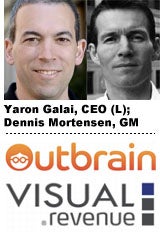 While much of the focus on data has been on the way marketers and ad agencies employ it, there are a few companies who work primarily with the editorial side on how best to target their content (and the advertising that supports it) to readers. That space is shrinking a bit today, as content discovery engine Outbrain acquires Visual Revenue, a predictive analytics company for online publishing. Read the release.
While much of the focus on data has been on the way marketers and ad agencies employ it, there are a few companies who work primarily with the editorial side on how best to target their content (and the advertising that supports it) to readers. That space is shrinking a bit today, as content discovery engine Outbrain acquires Visual Revenue, a predictive analytics company for online publishing. Read the release.
The merger comes at a moment when concepts such as “holistic yield management, native advertising, and content marketing are being heavily discussed as methods to broaden publishers’ revenue options beyond the typical confines of their own sites and the usual balance between editorial and advertising.
“We both serve publishers, but we found that our two systems are very complementary,” said Outbrain CEO Yaron Galai, in an interview with AdExchanger.
“We’ve known each other for about two years or more and are good friends through many of our mutual clients,” added Dennis Mortensen, CEO/founder of Visual Revenue. “It was probably December when we really saw how well our two pieces fit together. It was about bringing together article views and front page views — like peanut butter and chocolate. It’s a great match!”
At least for the time being, Visual Revenue’s brand will remain in existence, even as its 25 staffers join Outbrain’s current 210 employees. In discussing how the two companies fit together, Galai offered the analogy of two entities operating in the airplane construction industry.
“For Outbrain, it’s like we’ve developed the best auto-pilot system, while Visual Revenue has established the best navigation system for airline pilots – in this case, the editors – and up to now, they’ve been flying blind, so to speak,” Galai said.
Visual Revenue views itself as the operator of a “Bloomberg terminal” for editors, and has lately expanded its services into social media recommendation. The company’s software tells editors the best time to distribute certain kinds of content, with the promise that it can predict how well content can perform from a traffic and engagement standpoint at those times.
“For the foreseeable future, the Visual Revenue brand name will continue to live on,” said Mortensen, who will take on the role of general manager. “Long-term, whether that’s as an operating unit or a product name remains to be seen, but it surely is a good moniker for what we provide to the eyes of an editor.”
The acquisition terms — which remain undisclosed — were hammered out over the course of a few weeks, Galai said. There are no plans to expand the company’s focus beyond serving the publisher side, the merger will help improve what seven-year-old New York-based Outbrain can do in areas like native advertising and content marketing, which blur the lines to some extent between editors and ad sellers.
“We don’t see a difference between paid links and editorial driven pages — in essence, Outbrain is doing for content discovery what Google has done for search,” Galai said. “It’s all about helping users find the best, most interesting content. By merging Outbrain and Visual Revenue, we are combining the largest platform in the paid content recommendations space with the leading platform for editorial decision support.”
The purchase of Visual Revenue is Outbrain’s third deal in less than two years. In December, Outbrain acquired Scribit (formerly known as Vertical Acuity), a software company that allows brands to curate long form content from major publications on their site. That deal followed Outbrain’s acquisition of Surphace from AOL in February 2011.
Asked about additional acquisition plans, Galai said there was nothing on the horizon, but he’s not ruling anything out.
“We don’t search for acquisitions for the sake of doing deals,” he said. “We have historically looked for interesting competitors whose products relate to what we’ve developed, particularly around similar themes, such as helping bring the user content recommendation. If we see a good fit, we’ll try to play there. But it’s only about making our existing products stronger, it’s not about a need to increase market share or capture additional revenue in an area we’re not involved in.”










